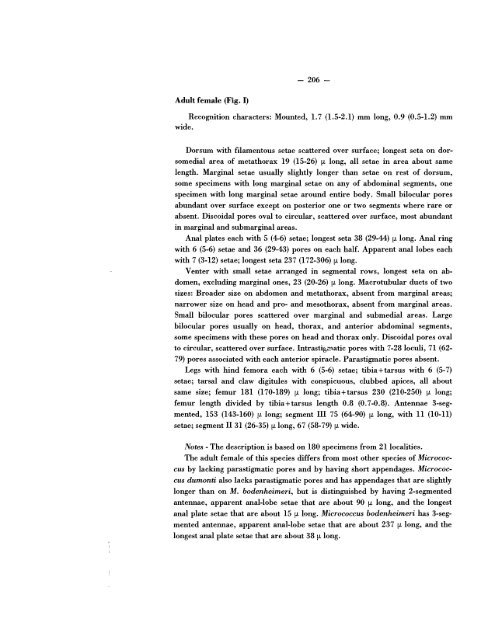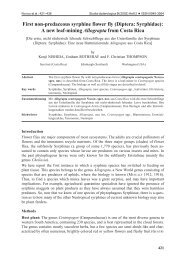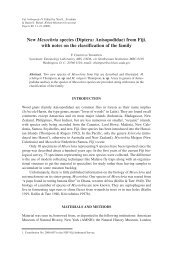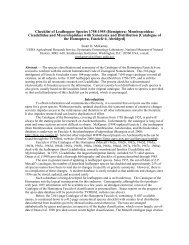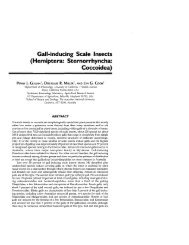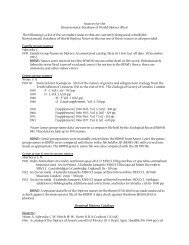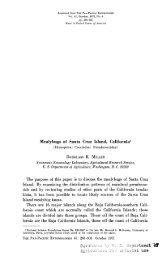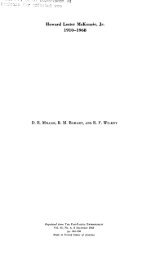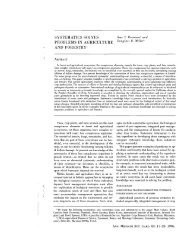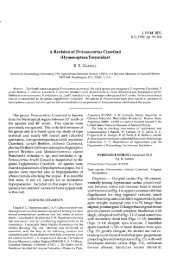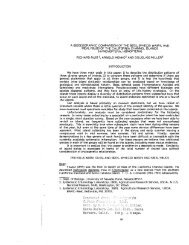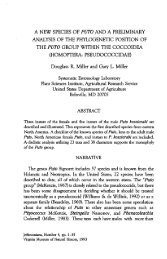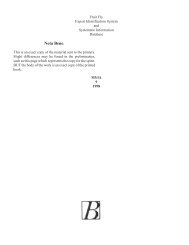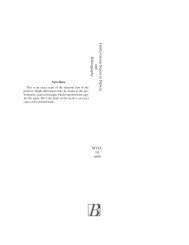Systematic revision of the Family Micrococcidae (Homoptera ...
Systematic revision of the Family Micrococcidae (Homoptera ...
Systematic revision of the Family Micrococcidae (Homoptera ...
You also want an ePaper? Increase the reach of your titles
YUMPU automatically turns print PDFs into web optimized ePapers that Google loves.
- 206<br />
Adult female (Fig. I)<br />
Recognition characters: Mounted, 1.7 (1.5-2.1) mm long, 0.9 (0.5-1.2) mm<br />
wide.<br />
Dorsum with filamentous setae scattered over surface; longest seta on dorsomedial<br />
area <strong>of</strong> metathorax 19 (15-26) fL long, all setae in area about same<br />
length. Marginal setae usually slightly longer than setae on rest <strong>of</strong> dorsum,<br />
some specimens with long marginal setae on any <strong>of</strong> abdominal segments, one<br />
specimen with long marginal setae around entire body. Small bilocular pores<br />
abundant over surface except on posterior one or two segments where "rare or<br />
absent. Discoidal pores oval to circular, scattered over surface, most abundant<br />
in marginal and submarginal areas.<br />
Anal plates each with 5 (4-6) setae; longest seta 38 (29-44) fL long. Anal ring<br />
with 6 (5-6) setae and 36 (29-43) pores on each half. Apparent anal lobes each<br />
with 7 (3-12) setae; longest seta 237 (172-306) fL long.<br />
Venter with small setae arranged in segmental rows, longest seta on abdomen,<br />
excluding marginal ones, 23 (20-26) fL long. Macrotubular ducts <strong>of</strong> two<br />
sizes: Broader size on abdomen and metathorax, absent from marginal areas;<br />
narrower size on head and pro- and mesothorax, absent from marginal areas.<br />
Small bilocular pores scattered over marginal and submedial areas. Large<br />
bilocular pores usually on head, thorax, and anterior abdominal segments,<br />
some specimens with <strong>the</strong>se pores on head and thorax only. Discoidal pores oval<br />
to circular, scattered over surface. Intrastig,iYlatic pores with 7-28 loculi, 71 (62<br />
79) pores associated with each anterior spiracle. Parastigmatic pores absent.<br />
Legs with hind femora each with 6 (5-6) setae; tibia +tarsus with 6 (5-7)<br />
setae; tarsal and claw digitules with conspicuous, clubbed apices, all about<br />
same size; femur 181 (170-189) fL long; tibia +tarsus 230 (210-250) fL long;<br />
femur length divided by tibia +tarsus length 0.8 (0.7-0.8). Antennae 3-segmented,<br />
153 (143-160) fL long; segment III 75 (64-90) fL long, with 11 (10-11)<br />
setae; segment II 31 (26-35) fL long, 67 (58-79) fL wide.<br />
Notes - The description is based on 180 specimens from 21 localities.<br />
The adult female <strong>of</strong> this species differs from most o<strong>the</strong>r species <strong>of</strong> Micrococcus<br />
by lacking parastigmatic pores and by having short appendages. Micrococcus<br />
dumonti also lacks parastigmatic pores and has appendages that are slightly<br />
longer than on M. bodenheimeri, but is distinguished by having 2-segmented<br />
antennae, apparent anal-lobe setae that are about 90 fL long, and <strong>the</strong> longest<br />
anal plate setae that are about 15 fL long. Micrococcus bodenheimeri has 3-segmented<br />
antennae, apparent anal-lobe setae that are about 237 fL long, and <strong>the</strong><br />
longest anal plate setae that are about 38 fL long.


